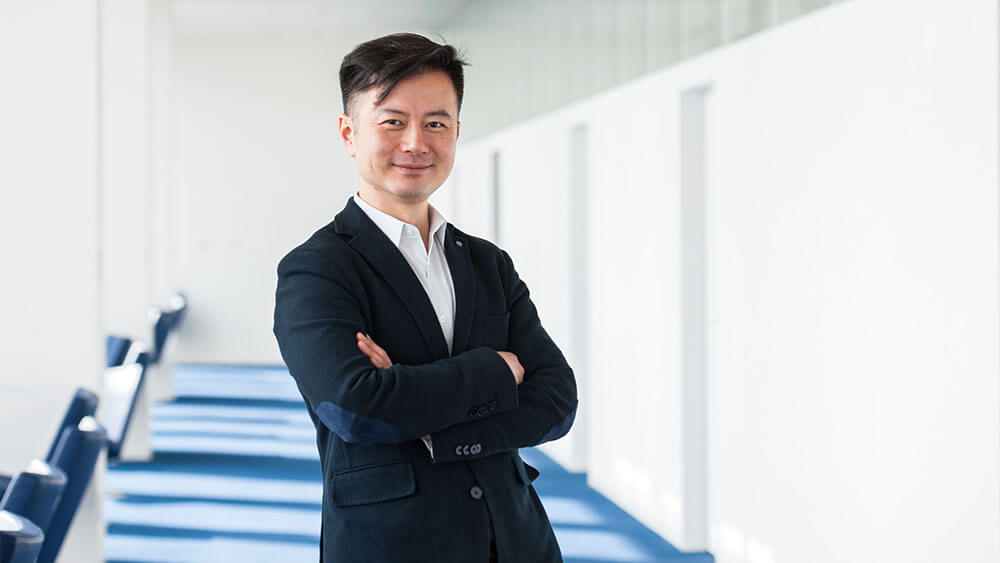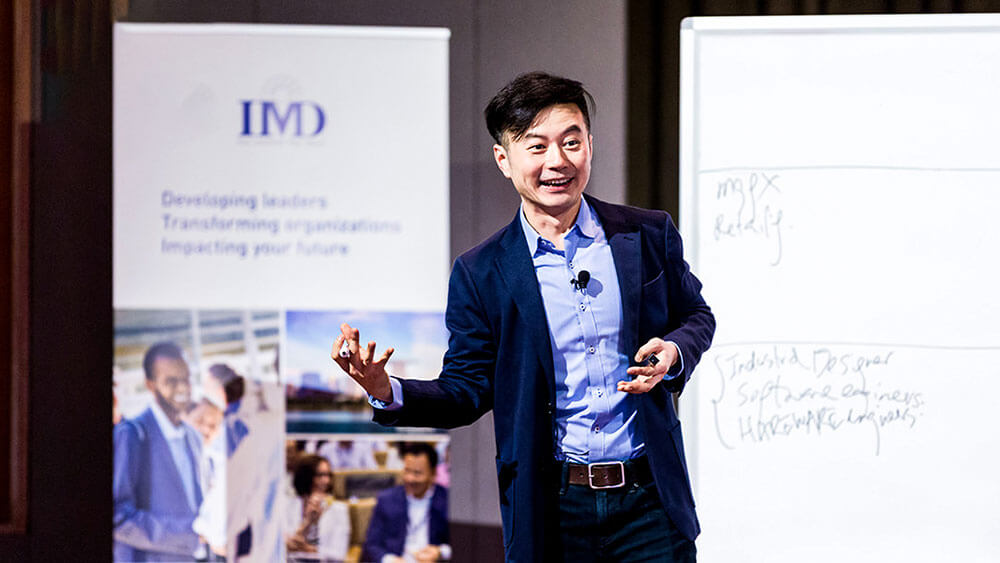
Because of the pandemic, said Convening EMEA keynote speaker Howard Yu, “there are organizations … that are much more poised for future growth. And there are some who kind of lag behind as a result.” (Photo courtesy Speakers Associates Ltd.)
Howard Yu will keynote PCMA’s inaugural Convening EMEA at Lausanne’s SwissTech Convention Centre 17-19, October 2021.
Yu is among the world’s top five innovation speakers and LEGO® professor of management and innovation at Switzerland’s IMD business school, where he heads up the Center for Future Readiness.
Yu spoke to Convene via Teams recently about just that: How organizations — and more specifically, business event organizers — can become future ready. It’s important work, Yu said, because future preparedness leads to resilience.
How has the concept — and the work — of future readiness changed as a result of the pandemic?
What we’re seeing is the pandemic is an accelerant. This is why being future ready is really important. The pandemic accelerated a number of secular trends that people kind of knew were going to be around — then boom, all of a sudden [the pandemic] changed the way we live and the way we work and the way we play. As a result, there are organizations — we could go sector by sector — that are much more poised for future growth. And there are some who kind of lag behind as a result.
So for instance, we all know e-commerce has been big, but all of a sudden [in] the first eight weeks during the pandemic last year, [e-commerce experienced] double-digit growth versus historically single-digit growth.
Within the retail space, you have winners like Nike, LVMH, where you see the share prices have not just recovered but generate something like one-hundred-percent-plus compared to before the pandemic. And then you have those who basically recovered the most — Burberry and Walmart, for example. Then you’ll have those that lined up for bankruptcy, right, like JCPenney and J. Crew. These are all traditional brick-and-mortar stores and traditional brands. None of them are digital native. What’s really interesting is all of them talked about digital strategy. From Burberry, to Macy’s, they all have that digital transformation — this is what they tell their shareholders.
But what differentiates those who succeed right now are the ones that are much more well-poised for future growth. They don’t just experiment — they actually scale this capability ahead of time. And as a result, during a time of crisis, they’re more resilient, they’re just ready for growth.
What are the ways that event organizers can be more prepared? How can they make sense of how what’s happening in the larger world will impact their audiences?
I think your question has two levels. One is as a strategy level: How do we conceptualize a conference attendee experience? How do we conceptualize a future type of experience — what kind of capability do we need to build and scale? But then you’re also tapping into another element. That has to do with [mindset]. How do we make ourselves future ready? So on your first question then, arguably, we’ve got to look for inspiration from adjacency. Companies that successfully transform while keeping their core intact [while also] adding on new stuff. I think this is what the audience probably would find most helpful — not to jettison completely off who we are, but you add on something specifically.
In essence, we need to practice scenario planning, scenario mapping. No one can predict when COVID is going to be completely done. You can be an optimist, you can be a pessimist, but no one should bet all their money on one single scenario. It would be like if you think Tesla is hot, then you invest all your pension, your entire retirement into only Amazon and Tesla. No one’s going to do that.
But when it comes down to corporate strategy, we go into that way of thinking — it’s black or white. By the end of 2021, we’d return to normal or we would never return to normal. That’s a wrong way of thinking. What we need is to develop a number of scenarios and then you kind of put what is the probability against each of them. And you derive an investment strategy to build a capability to hatch across all of these, which is exactly what an investment is. Don’t think the cinema is going to go away. No way. And never think cruise lines are going to stop forever, nor are they going to open up right away.
So back to your question, what does it mean [for the business events industry]? Well, very, very tangibly, an investment into digital capability is a no-brainer. So then we’ve got to think, okay, so how do we increase customer stickiness? Now let’s look around. Who are the winners? Winners are the ones who build a direct relationship with that participant, right? [If you offer] just a one-off event, that lack of ongoing relationship-building with a target audience is problematic, to say the very least.
If you look at all the B2B companies in the world, they all go to direct to consumer. Why is that? Because you’ve got the data, you know what they need, you can curate, you can auto execute. So as an event organizer, we need to think beyond an event. Business schools do the same thing.
For event organizers, one direct draw of analogy is to look at what business schools are doing, and how the higher education landscape is changing. What we’re seeing is people don’t care too much about the campus itself. But it’s the professor’s direct relationship with participants, especially in executive education, [that’s important]. You see Scott Galloway [an adjunct professor of marketing at the New York University Stern School of Business, and a public speaker, author, and podcast host] and other star professors are building that direct relationship to a huge, wide audience.
So you really can be tapping into the insight about your audience and keep on upselling. I think that is a sort of overarching general principle that we could start thinking about — looking at the adjacency markets and bringing and building the direct-to-consumer and participant relationship across.
That leads to the hot stuff around innovation. What type of content would inspire them? What kind of partnership with other service providers could you join forces with to make those offerings exciting and fascinating so that you stay close with your target audience? In the end, you want to [have] constant connectivity, which means a very easy-to-use digital interface. That interface needs to be easy for your target to have a value proposition, but also easy to plug and play with other service providers at the same time to channel content to your audience.

Howard Yu lectures at the IMD business school in Lausanne, Switzerland. Yu is a LEGO® professor of management and innovation there, and leads the Center for Future Readiness.
You touched on drawing inferences from business school. Based on your experience as a professor, what have you learned during the pandemic in terms of online education and engagement with your students that may be applied to the conference industry?
It’s been quite a humbling experience because as a professor, you think people come to a school because of you. The pandemic really shows you it’s not [the case]. They want networking. So in online education, what happens is if there is no project, if there’s no online community, the value proposition is very weak. Now particularly once you’re online, people really benchmark you against TED Talks and all of the LinkedIn Learning, and so on.
I think this is part of why the event organizer finds it quite scary — this scenario, particularly. Because when the participants are not meeting face to face, then they start to see the event as another benchmark against a free webinar. So where do we play? I think people still haven’t cracked the magic of using online to build community yet. People talk a lot [in these communities] but it’s really not a strong community because there’s a lack of mission.
I think from the online education what I’ve learned is the project work is key, particularly group project work. They form smaller teams to explore a certain topic with common interest. … that is a strong cohort. That is so important. I think that, translated to event organizers, could we start to think — how can we make sure these are not just digital one-off events, but build a journey across that there is a sense of community, that we are sense- making in a very confusing world and yet leveraging this broader reach. … Once you get rid of the geographical boundary, then each of these becomes an input while you have a community, almost like a book club to go through that journey with a group discovery.
Have you done any speaking at a conference online and have you spoken in person at a conference since the pandemic? And what are the differences between those experiences for you?
Yeah. So there are two types of online conferences. One is the one that I described — much more of a journey, not a one-off. So there are companies that come to IMD, but it’s completely virtual. We build essentially a 12-month journey with a cohort of around 40 and they break out into smaller teams to learn. So that’s one type. [
I’ve also recently spoken in person to a group of more than 100 in Denmark.
My experience is, of course, nothing can replace human interaction. It’s just so nice to see fellow humans in person, and then the networking and the buffet and things like that, of course. Whether we could still do it, again, going back to scenario mapping, towards the end of this year — how likely we could do it given the Delta variation, and it’s a huge unknown. One moderate outcome could be, [you could have] an in-country type of regional conference. The sort of global conference [we knew before the pandemic] may still be severely hampered [by] the different pace of vaccinations around the world. But you could tangibly think maybe an in-country event with all the precautions in place, that could be a possibility.
Now if that’s the case, then there are two elements that are severely constrained.
Without global audience or global speakers then the event in terms of content may feel a little bit more constrained, which means that it’s not really hybrid, I would call blended. Because hybrid would be an audience outside. Online, I don’t know. That’s never really worked out well because you create two classes of audience immediately. But a blended would be interesting, right? So you have the face-to-face, but you will have the virtual element and you have the virtual afterwards, that the experience in terms of content doesn’t get constrained because speakers cannot travel. But then the in-person, the networking is still there. Then I think it’s interesting.
Michelle Russell is editor in chief of Convene. This interview has been edited and condensed.
To learn more about and register for Convening EMEA, visit conveningemea.org.
